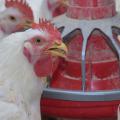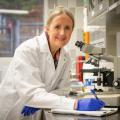Sanitation of hatching eggs
All incubatior factors like temperature and humidity can be operating just right but poor hatchability can result because of poor sanitary practices. Poor sanitation causes not only poor hatch but subsequent early death loss during brooding. It can also cause a lingering morbidity problem that sometimes affect the birds during the grow-out period. Losses during the brooding and grow-out period caused by poor hatchery sanitation can cause more monetary loss than the loss from poor hatchability.
Let's assume you are setting clean, well cared-for eggs.
The most important tools available for use in cleaning and disinfecting an incubator and hatcher are water, detergent, and elbow grease. Some people mistakenly think disinfecting agents are the answer to their problems. They think disinfectants can replace poor cleaning, but this simply is not true.
Remember this: It is almost impossible to disinfect a dirty environment. Why is this statement true? Because all disinfectants lose much of their effectiveness as soon as they come in contact with organic matter; the dirtier the surface being sanitized, the less effective the disinfectant being applied.
Some disinfectants are more effective in the presence of organic matter than others. Cresol, cresylic acid, and coal tar disinfectants are the most effective disinfectants in the presence of organic matter. Since they are corrosive and emit noxious and toxic gases, they are not normally used in incubators, but in cleaning and disinfecting bird houses and pens.
The most commonly used disinfectants in the hatchery are quaternary ammonia compounds (quats), multiple phenolics, and iodophors (iodine compounds).
Quaternary ammonia may be the most commonly used disinfectant for equipment like incubators and hatching trays because quats are relatively non-irritating, non-corrosive, of low toxicity, and reasonably effective in the presence of organic matter. Since the incubator and its components should be cleaned free of organic matter before applying a disinfectant, quats are a good choice.
Many hatcherymen use multiple phenolics. They have a wide germicidal range, low toxicity and corrosiveness, reasonably good effectiveness in the presence of organic matter, and good residual effect. The disadvantage is that multiple phenolics can cause a burning effect on the skin of anyone handling them in a strong solution or during a relatively long period of time. If using multiple phenolics at concentrations greater than the solution strength suggested on the label, wear rubber gloves for protection.
Iodophores have wide germicidal activity, good effectiveness in the presence of organic matter, and cost less than quats or multiple phenolics. The disadvantages are that it stains, is corrosive when in acid solution, and has only a slight residual activity.
A thorough cleaning job using plenty of elbow grease results in a 95 to 99 percent microbial removal. In such case, and when done often enough, little or no disinfectant is needed (assuming you are setting clean eggs). If, on the other hand, you are using a quick "hit or miss" system and a long time passes between thorough cleanup jobs, you are most likely falling short in disinfecting your machines. It is best to use a disinfectant following cleanup and maybe between cleanup jobs.
Publications
News
STARKVILLE, Miss. -- Until an avian flu vaccine for chickens or other alternative is federally approved, commercial poultry operations in the U.S.
STARKVILLE, Miss. -- If egg prices have seemed higher than ever lately, it’s because they are, and consumers can place much of the blame squarely at the feet of the ongoing bird flu outbreak.
With highly pathogenic avian influenza, or HPAI, in the environment in Mississippi, owners of backyard flocks have to take extra steps to keep their chickens healthy.
Avian influenza poses an extremely low risk to human health and none to food safety in Mississippi, but its presence poses a risk to backyard flocks and the state’s $3 billion commercial poultry industry.







